
The 2021 Criminal Justice Joint Inspectorate report ‘Neurodiversity in the Criminal Justice System’ highlighted that the prevalence of neurodiversity is much higher than has previously been reported. Encountering the criminal justice system is incredibly stressful and worrying, especially for young adults who require additional support. That’s why we recently spoke to Professor Huw Williams and PhD Researcher Hope Kent from The University of Exeter about their work in this area and how the current system can be improved.
Assessments in police custody
Young adults can present with various needs, including acquired brain injury (ABI), neurodiversity, ADHD, autism, as well as language and communication issues. Huw recognises that this can be daunting for professionals.
“How do we bring in a system for people to better recognize the signs and signals of neurodisability? We don’t want frontline staff to be overwhelmed by the complexity of the information but to be better equipped in the interaction with the person and think about how to support them because they’re vulnerable.”
32% of under 18s interviewed in the secure estate have a learning disability1 (compared to about 4% of the general population). Unfortunately, similar data related to young adults aged 18 to 25 is not documented. However, we can safely assume that a significant number of young adults are coming into custody with additional needs.
That makes the screening process crucial. If young adults are properly assessed at this first point of contact with the justice system, their charges can be mitigated, and they can be diverted into local support systems. Particularly for those aged 18-25, proper screening could be the difference between being supported by an Appropriate Adult in police custody or not.
“We have supported various projects to help police to screen for brain trauma. Hope and I did some work with Devon and Cornwall Police, specifically with their Pathfinder diversion program. The team fed back that they saw the need to pick up on mild brain injury more effectively so that staff could be more mindful of how it affects people and make appropriate adjustments – which could be simple, like issuing regular reminders for appointments.”
As police forces operate independently, it’s challenging for best practice approaches, like this project in Devon and Cornwall, to be shared widely. Instead, there are often pockets of good practice.
Risk versus vulnerability
Earlier this year, Hope was working on a research project exploring the impact of the PACE safeguards on the detention and questioning of children in custody2. She requested custody record data from the 43 territorial police forces in England and Wales. One of the factors examined in the project was the quality of information police forces were recording about the vulnerability of children appearing in custody.
She explains: “We heard back from 12 forces who could provide us with electronic datasets – eight of which were of high enough quality to include in our analysis. The vulnerability flags that police forces use varied hugely across the 12 forces and were generally collected under the heading of ‘person warning flags’. The number of electronically recorded ‘person warning flags’ ranged from 3 in some forces, to 12 in others. They also ranged significantly – including ‘Mental Health’, ‘Mental Disorder’, ‘Suicidal’, ‘Escaper’, ‘Drugs’, ‘Contagious’, amongst others.
“Flags for things that might make a child or young person particularly vulnerable in police custody, such as a mental health condition, are collected along the same lines as flags for their management in custody, such as ‘escaper’.”

“It’s clear that the vulnerability flags are not fit for purpose, and the consistent electronic recording of more detailed information would enable proper enforcement of safeguards for children and young people who need them.”
A unified approach to screening
The picture that starts to emerge is one where people’s vulnerability is viewed through a lens of risk, rather than a supportive lens that seeks to identify appropriate support or interventions. Hope believes that a more joined-up approach will help improve the situation.
“In South Wales, there are people working in police custody who understand this problem and have put screening in place, but there needs to be top-down management of what the forces are expected to collect.
“The quality of the data that police forces can easily access electronically was poor. The police forces don’t have to electronically report this data back to the home office and, without this requirement to report on people’s vulnerability, it’s incredibly hard to understand what’s going on ‘on the ground’ in custody suites.
“Asking for quality, routine data collection would make sure police forces ask questions about vulnerability in a much more consistent way.”
Effective identification of brain injury and neurodiversity
Huw Williams and Hope Kent are currently working on a research project with Thames Valley Police force. Huw and Hope were tasked with reviewing how neurodevelopmental issues and trauma may increase a young adult’s likelihood of coming into contact with the criminal justice system.
The aim is to be able to effectively identify experiences in someone’s background that may be indicative of a brain injury, and to help the police to divert people into appropriate rehabilitation services.
“We’re working with Thames Valley to work out what’s appropriate to screen for too because there’s lots of issues when children are involved as the courts can use information gained during the screening process against young women,” Hope explains.
“Police sometimes aren’t the best agency to have very sensitive information about people, but they’re often the ‘first responders’ in situations like domestic violence. So, we have to ask, what actually should go on record, what should be screened for, what the police should know about to support that person, and whether a functional assessment of what that person might be struggling with is better than having a brain injury on record?”

Functional assessments versus diagnostic assessments
Hope has also worked with Professor Amanda Kirby who created the Do-IT Profiler screening tool – a holistic assessment that considers an individual’s whole experience.
“Amanda was getting frustrated with diverse needs like autism and ADHD not being picked up and assessed properly. Do-IT Profiler operates in schools, universities, workplaces, but also in the prison system.
“They’ve worked collaboratively with prisons to design assessments that give staff the information they need to be able to support someone in education and also in their reintegration into the community.
“Do-IT is designed to be very holistic – they conduct whole person assessments. They collect somebody’s education history. Were they ever in care? Who did they live with before they came to prison? Are they struggling with homelessness, substance use, medical problems? Have they ever been diagnosed with the neurodisability?”
This innovative tool also incorporates a variety of functional assessments to better understand what support a young adult might require.
“The tools include both self-reporting and cognitive assessments – to help prison officers understand whether an individual has the skills they need to be able to go to probation appointments, for example. Do we know if they can read a bus timetable? It then produces a report for the prison that says this person might struggle with their memory, for example, and here are some simple techniques you could use to help them.”
What’s unique about this tool is the focus on function over diagnosis. This means prison staff don’t have to be experts in multiple conditions to understand what support a young adult might need.
International approaches to young adults and neurodiversity
Huw has also been looking at how criminal justice systems in other countries are supporting young neurodiverse adults.
“There are some really nice examples in the US of having social workers involved in policing, so instead of going down the arrest route, you’d be going down the support route. In New Zealand, there’s been shifts in the system so that, up to the age of 25, you are much more likely to be assessed for a neurodisability to see what support you need. So instead of going into the prison system, you’re given a community order.
“60 or 70% of police work is supporting people who are vulnerable, but this is the wrong place for people to end up. A shift in what policing does is really important, a move towards a trauma-informed supportive stance.
“But you need a system in place for that to happen, and for the police to have confidence in this approach, and local stakeholders and crime commissioners to have a stake in that and see the purpose in that.”
Bringing all the partners to the table
It’s clear that a joined-up approach – involving local health and social care partners – is needed across the criminal justice system to ensure that young neurodiverse adults are properly assessed, given appropriate support, and diverted away from crime.
“We need better systems with all the stakeholders engaged and sharing information. Rather than escalate things down the criminal justice route, you can have a more supportive response.
“What we’re calling for would be adoption of a youth justice system, in the sense that you know the young person who’s in the system is the product of what’s happened to them in early life – including adverse childhood experiences – and the responses from education, health, and social care systems. The point of the justice system should be to alert us to what support they need. But the current system doesn’t do that.”

“There’s a level of ignorance, a not wanting to understand” – Raising Awareness of Acquired Brain Injury (ABI)
Read moreWorking with the VCSE to deliver better outcomes for Black, Asian and Minority Ethnic young people
Race and ethnicity, Transition, Young adults
T2A Chair Leroy Logan MBE reflects on the findings of the Alliance for Youth Justice’s (AYJ) briefing paper on the transition from the youth to adult justice system – focusing on the experiences of Black, Asian and Minority Ethnic young people.
A spotlight on racial disparities
As the briefing suggests, young people who turn 18 while in contact with the justice system face a steep cliff edge. Studies show that this age is a crucial turning point where many young people begin to desist from crime with the right support and interventions. But rather than take advantage of this capacity for change, statutory services fall away. For Black, Asian and Minority Ethnic young people, the transition to the adult justice system can be even more challenging.
This latest briefing from AYJ has cast a harsh spotlight on the failings of our justice system to address the racial disparities that have blighted many young people’s lives. From an early age, many Black, Asian and Minority Ethnic young people find themselves associated with criminal stereotypes. Labelling young people in this way is incredibly damaging, eroding self-belief and making it harder to move towards a pro-social identity.
Once Black, Asian and Minority Ethnic children enter the justice system, they are less likely to be diverted, more likely to receive harsher sentences, and more likely to be sent to custody, sentenced or on remand, compared to white children1.
“Guilty before proven innocent… you kind of learn authority figures don’t actually care.”
Young Person
This can create a huge gulf in understanding and trust between Black, Asian and Minority Ethnic young adults and the professionals working in the system.
Sadly, these findings confirm what many of us working in the sector already expected. That’s why I welcome AYJ drilling down into the causes of this crisis, and what needs to change to deliver better outcomes.
Too often, we focus solely on what’s not working and forget that we must create a roadmap for the future we wish to see.
An overstretched and under resourced system
It’s clear that even with a diverse workforce, culturally competent training, and the best will in the world, the probation service is struggling to keep its head above water.
A professional quoted in the briefing had this to say:
“Record levels of staff sickness, extended sick leave, people fleeing the service in droves – that then exacerbates every other issue we have. We can’t be ambitious, we can’t be progressive, we can’t make many changes if you’re barely able to keep the regime running.”
There are many admirable professionals working in the system who want to do better for young adults, but they don’t have the time, resources, or support to implement creative approaches.
Without sufficient investment, the system can barely meet young adults’ basic needs – let alone support them to take steps towards a more positive future.
Collaboration with the VCSE sector
In this depressing climate, the work of voluntary and community organisations has become even more vital.
Specialist Black and Ethnic Minority-led organisations have an intimate understanding of the communities Black, Asian and Minority Ethnic young people come from and how their experiences inform their behaviour and identity. As the research highlights, these grassroots organisations are well placed to provide nuanced support that recognises these young people’s overlapping needs – support that statutory services would struggle to provide.
These organisations are also more likely to have lived experience embedded in their staff and support services, meaning they can provide peer mentoring and positive role models – both of which are essential components in facilitating the shift towards a pro-social identity.

Ring-fenced funding to commission specialist organisations
I believe that we could take this further by developing a model where specialist Black and Minority-Ethnic led grassroots organisations are commissioned to operate services in their communities. Funding would be ring fenced for these local organisations who have the expertise to deliver the best outcomes.
This model could be supported by local roundtables where information and knowledge are shared regularly so that young adults can access support from multiple agencies. Meeting in this way will also help criminal justice agencies better understand how these organisations are well placed to support young adults. Having buy in from all partners will be vital to the success of this model.
The Newham Transition to Adulthood Hub is a great example of how this approach can work in practice. They have a wide variety of services in one space, so staff can consult each other on individual cases and referrals to different services are much easier and more efficient. Regular spotlight sessions are held where different teams share their expertise and explain how their services can benefit young adults.
Grassroots organisations excluded from funding opportunities
Unfortunately, the AYJ’s report found that organisations with strong community links and knowledge are effectively excluded from funding opportunities. They lack the resources to compete with larger organisations who can meet the excessive commissioning processes and compliance requirements demanded by the Ministry of Justice and HMPPS.
However, many of these larger organisations lack the knowledge and cultural competence to successfully deliver these services. Shockingly, they often subcontract their services at a lower rate to the very grassroots organisations that have been denied a place at the table.
It is crucial that the Ministry of Justice and HMPPS immediately reform VCS funding allocation so that specialist Black and Minority-Ethnic led grassroots organisations can build the capacity of their services – ensuring every young person receives age-appropriate, trauma-informed, culturally competent services that reflect their entire lived experience.

Bridging gaps and changing tracks
Alliance for Youth Justice briefing on supporting racially minoritised young people transitioning from the youth to adult justice system.
Read report- xxvii Microsoft Word – BAME research report_final_v4.docx (publishing.service.gov.uk); Centre for Justice Innovation (2021) Equal diversion? Racial disproportionality in youth diversion; JUSTICE (2021) Tackling Racial Injustice – Children and the Youth Justice System ↩︎
Leaders Unlocked celebrates six years of providing young people with the space, support, and tools they need to lead
News and events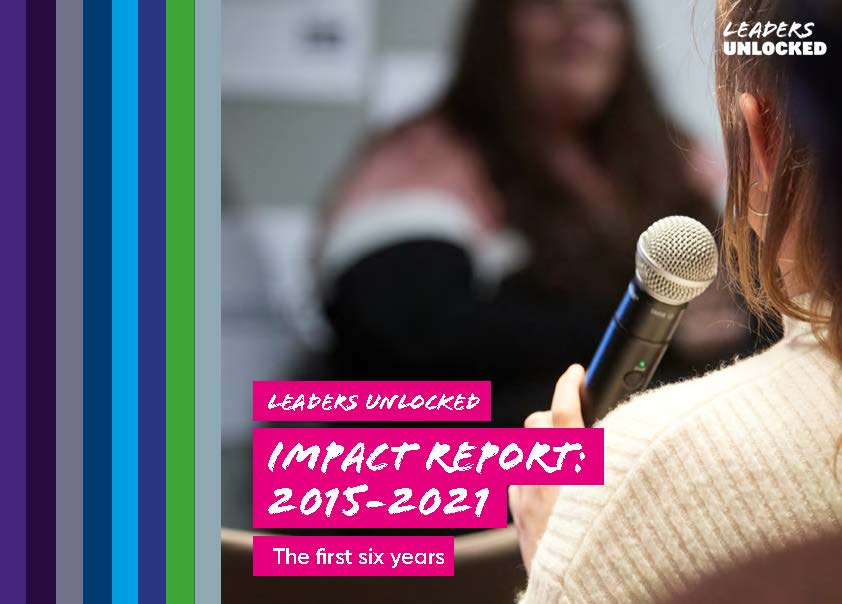
Leaders Unlocked supports young people from diverse backgrounds to influence change on the issues that affect their lives. It was founded by Rose Dowling in 2015 with the belief that any young person could become a leader if the right conditions were created for them to thrive.
Since 2015 Leaders Unlocked projects have provided young people with the space, support, and tools they need to lead. Completely youth-led, Leaders Unlocked enables young people to define their own priorities, produce their own research, develop recommendations and co-produce solutions.
In 2020, Leaders Unlocked established a Youth Board – a group of motivated young leaders representing all of its work areas: criminal justice, education, health, and policing. These young leaders are helping to drive Leaders Unlocked’s growth as an organisation – working on its strategy, business development, partnerships, media and communications. The Youth Board of Leaders Unlocked have co-produced and authored this Impact Report – a vibrant record of its collective achievement over the last 6 years.
Follow @LeadersUnlocked
Diverting young adults from the cycle of crisis and crime: RDA evidence review
News and events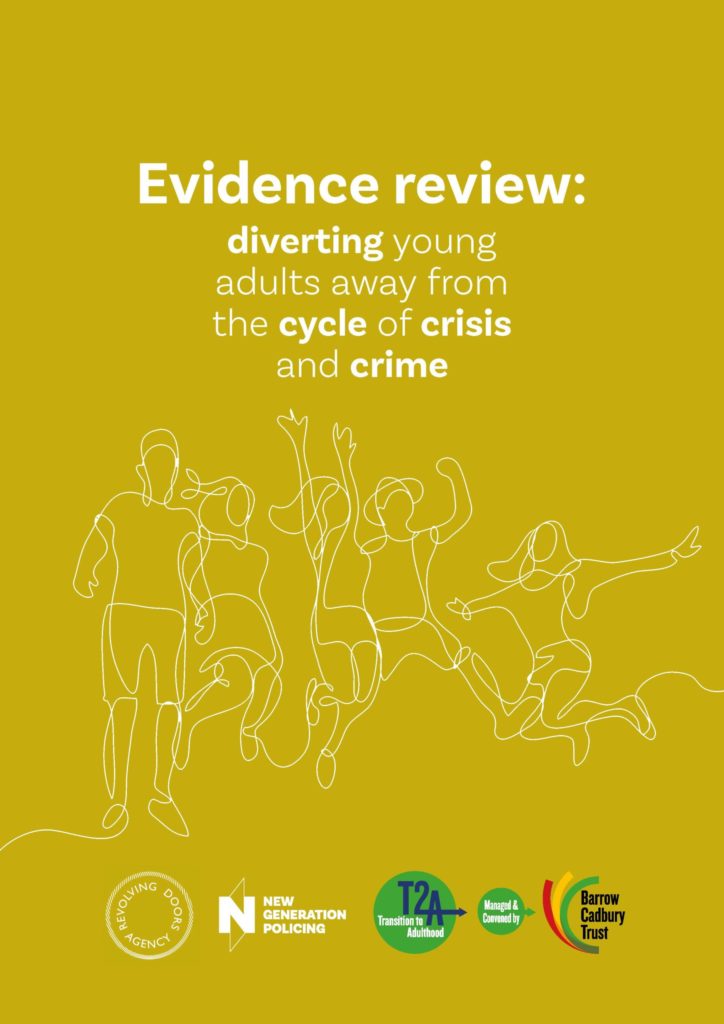
The new evidence review by the national justice charity Revolving Doors for T2A (Transition to Adulthood), reveals that delivering tailored interventions that meet the health and human needs of young adults can turn young people’s lives around, reduce crime and improve public safety.
The review brings together the latest evidence and emerging good practice that are shown to support young adults to move away from the criminal justice system. It highlights the need to scale up investment in police assisted diversion services to meet the ever-rising time demand on policing and courts.
Evidence from this review recommends that police-assisted diversion services should:
- Avoid prosecutions for low-level and non-violent crimes where possible to have the most impact
- Deliver tailored responses to meet the specific needs of young adults’ health, human needs and maturity
- Apply trauma-informed approaches to understand root causes of crime and minimise harm
- Adopt a gender-specific and culturally competent approach to achieve equable outcomes for young adults in the criminal justice system
- Promote a pro-social identity that builds on their strengths and abilities and empowers them to shape their own future
- Link young adults and their families into sustainable and long-term support to prevent future crises.
Pavan Dhaliwal, Chief Executive of Revolving Doors Agency, said,
“The benefits of out of court disposals are generally well known but what is often lacking is evidence about works about these programmes specifically and importantly given the fact that they make up around a third of all police cases, what works in reducing reoffending in young adults.
This new review shines a light on interventions that are most effective for diverting young adults into support. It pushes the New Generation agenda forward into practical steps towards reducing reoffending and offers the chance for young adults to turn their lives around.
With magistrates’ courts backlogs expected to rise ten-fold, it is vital that police and crime commissioners invest in diversion services so that the police can deal with low-level crime effectively.”
Natasha, New Generation young adult campaigner, said,
“What made the biggest difference for me was having a consistent support worker who worked with me at every step of my journey, taught me how to notice patterns, followed up after I left the service, and encouraged me to seek help. I liked how they did not judge me or make me feel less than. This made me see the light at the end of the tunnel and push me to make the positive changes and embark on my journey to change.”
Joyce Moseley, Chair, T2A said:
“T2A (Transition to Adulthood) has been working to develop and collate best practice evidence from the UK and globally to understand how young adults (18 to 25) can best be supported to move away from crime. This report from the Revolving Doors Agency makes a valuable contribution to that evidence base of diversionary approaches for young adults. Young adulthood can be a time of high offending but it is also the period where with the right interventions rapid desistance from the cycle of crisis and crime can be achieved.”
Young Adults and Remand
Young adults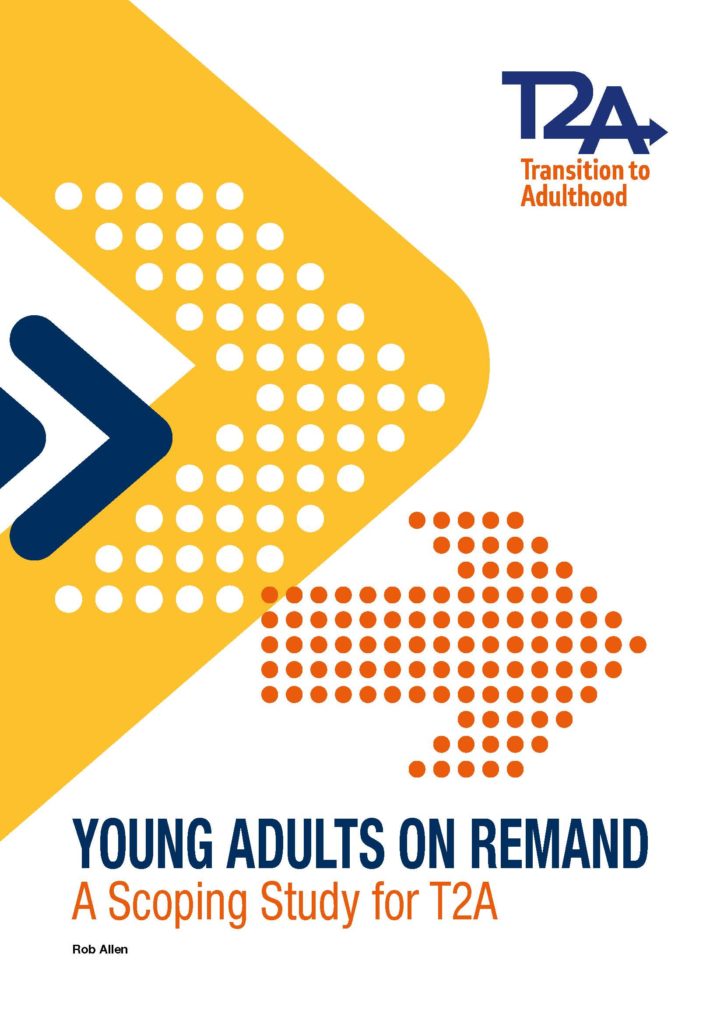
A new T2A (Transition to Adulthood) briefing on young adults and remand launched today makes the case for a reform of remand arrangements for the young adults.
A substantial and growing evidence base has found that young adults aged 18-25 are a distinct group, because they are still maturing. Interrupting a young adult’s development with a period in custody should only be made as a last resort.
The T2A report comes hot on the heels of the Chief Inspectorate of Prison’s short thematic review ‘Outcomes for Young Adults in Custody’, which was highly critical of the Government placing young adults in adult prisons without any coherent strategy, despite a decade of research and evidence explaining the uniqueness of the needs of young adults.
Specific data is not available about the extent to which young adults remanded to custody subsequently receive a custodial sentence but in the case of children under 18 and women of all ages, most do not.
Although there has been a decline in the numbers of young adults remanded in custody, the report argues there is scope for reducing them yet further.
Recent research by Ed Cape and Tom Smith found that “nearly half of those people who are kept in custody at some stage before their trial or sentence were either found not guilty, or if found guilty, were given a non-custodial sentence”.
In the context of a growing court backlog and highly restricted regimes in prisons because of the COVID-19 pandemic, the report’s author, Rob Allen, argues “it is particularly timely to consider the case for reform of remand arrangements”. ‘Extended Custody Time Limits’ introduced in September 2020 to manage court delays, threaten to leave thousands of people on remand in custody for longer than usual. Young adults are spending longer in custody as a result of these court backlogs which were already problematic prior to the pandemic.
The recognition of the need for a distinct approach to young adults has already led to a number of important criminal justice reforms such as expanded explanations in Sentencing Guidelines about how age and immaturity can affect both a young adult’s responsibility for an offence and how a particular sentence may impact on them. However, there has been no corresponding reform for young adults on custodial remand who, the report says: “can be deprived of their liberty for many months, often experiencing very impoverished regimes and … placed at risk of violence and self-harm”.
The briefing examines to what extent the specific developmental needs of young adults are taken into account by courts when making decisions about whether to remand defendants into custody. It also looks at the existing legal provisions which could be applied at the remand stage of criminal proceedings, and whether criminal justice agencies and courts think about the maturity of young adult defendants when making decisions about remanding them.
If young adults aren’t remanded in custody the report looks at what alternatives are available, particularly young women, and defendants with mental health problems.
Finally it looks at what measures might be taken to improve the distinctiveness of remand arrangements for 18-25 year olds? Read ‘Young Adults on Remand’.
T2A responds to Prisons Inspectorate Thematic Report on Outcomes for Young Adults in Custody
Young adultsT2A (Transition to Adulthood) welcomes the publication of this important short thematic report on Outcomes for Young Adults in Custody which makes it clear that there is a lack of a clear strategy for young adults in custody, resulting in lost opportunities and poor outcomes. Although some individuals working in the prison system are highly motivated, their efforts are hampered by the lack of a systematic approach, integrated strategy and limited resources for this age group.
The Chief Inspector’s report endorses many of the key findings and recommendations of a decade of T2A research and other independent reviews of how this age group are dealt with in prisons. We have long-advocated for distinct prison estate accommodation for this age group — separate from the over 25s — including well-tailored, developmentally-appropriate regimes that addresses the distinct needs – and opportunities for change – presented by young adults. Outcomes for young adults have been poor for a considerable time and will be exacerbated by the current pandemic. T2A has been particularly concerned about outcomes for people of colour, people identifying as gypsy, traveller and Roma, and care experienced young people in and following custody. A more effective approach would understand the experiences of these people as well as young adults more generally and build on the numerous examples of effective practice undertaken in other jurisdictions in the UK and internationally.
The Government can do more to stop these young people from becoming lifelong criminals who undermine our public safety. It is imperative that this evidence and the volume of credible voices calling for change are reflected in the Sentencing Bill when it comes before Parliament, otherwise an ‘open goal’ opportunity to reduce reoffending and be smarter about how we treat this group will be missed.
Joyce Moseley, Chair of T2A said: “It is frustrating that despite practitioner, academic, government and Inspectorate findings, we have seen so little progress for young adults at a time when the criminal justice system so needs an evidence-based strategy to mitigate the impact of the pandemic. If the Government fails to act on yet one more damning report it will be another indictment of its failure to respond to the needs of a lost generation of young people, locking them into a cycle of crime and undermining public safety.
Preventing young adults being caught in the ‘revolving door’
Young adults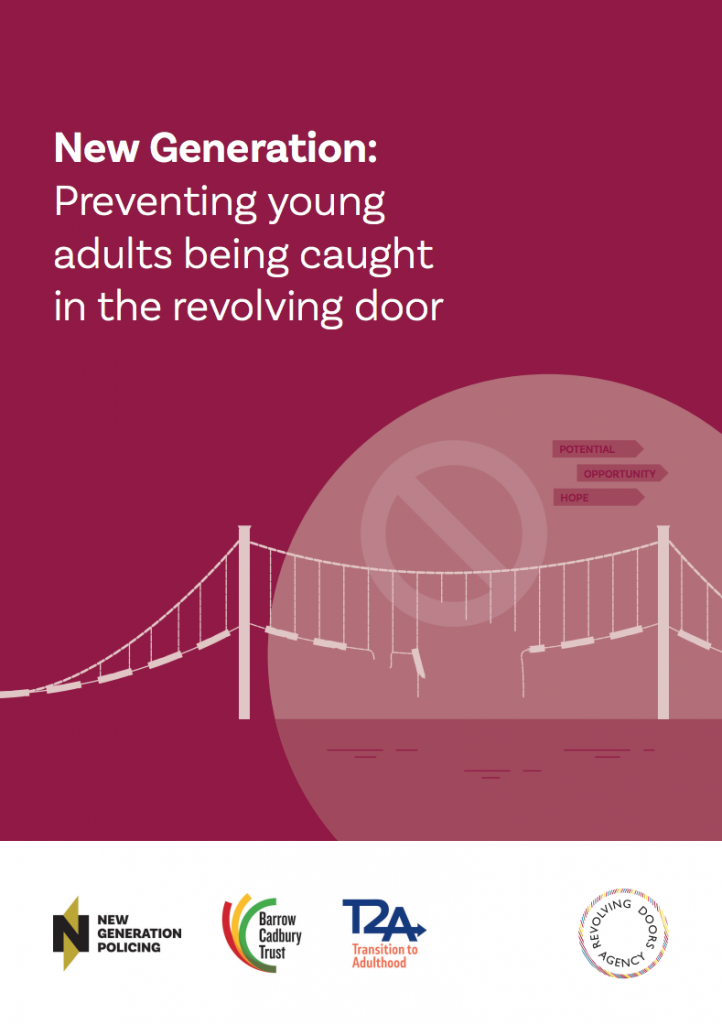
New data obtained by Revolving Doors Agency under the Freedom of Information legislation reveals that:
- Over half of all reoffences committed by young adults are theft and summary non-motoring offences.
- Young adults whose index offences are theft and summary non-motoring offences also have the highest rates of reoffending in the same category as their index offence.
- Theft creates the highest level of churn of repeat offences in the same category, with a ratio of 994 reoffences per 1,000 reoffenders.
- This rate is strikingly above any other crime category. It is 12 times higher than repeated possession of a weapon (for example carrying knives) and 6 times higher than repeated violence against a person.
These new figures expose the difference in demand created by young adults committing more serious and sometimes violent crime and the group often called ‘the revolving door’ who commit persistent low-level offences driven by a combination of needs stemming from complex trauma and poverty. These repeated, non-violent offences drive demand for our police, courts and justice system but are driven by underlying, unaddressed need.
The volume and churn of young adults who are sucked into the criminal justice system for relatively minor offences highlights the need for a radical new approach. The current failing approach resulted in the proportion of people with a history of repeat offending reaching at its highest ever level, accounting for nearly two fifths of all offenders.
This stark evidence comes at the same time as Revolving Doors publish an evidence briefing “New Generation” highlighting the critical role of Police and Crime Commissioners and police services in preventing the new generation of young adults entering the revolving door. The report brings together new perspectives on characteristics and needs of young adults entering the revolving door.
Revolving Doors Agency has also announced that they are offering bespoke consultancy and intensive on the ground support for five areas to kick-start local initiatives. These sites will benefit from their research, lived experience, policy, and service design expertise. Their support, which will be free of charge, can help Police and Crime Commissioners and their offices implement new strategies to support better options for young adults, such as deferred prosecutions or diversion schemes to keep young adults out of the criminal justice system.
New approach to young adults in court could cut reoffending and create fewer victims of crime
News and events
A new report, published today by the Centre for Justice Innovation and T2A, suggests that a fairer and more distinct approach to how courts deal with young adults could reduce reoffending, meaning fewer victims of crime.
The report ‘A fairer way: procedural fairness for young adults at court’ sets out a blueprint for a new approach to 18-25 year olds in court, developed over the last two years by criminal justice practitioners, as well as young adults themselves, in five areas of England and Wales. These areas have worked with the Centre for Justice Innovation to develop a model that could be delivered within current law and at no extra cost to the public.
This new approach has the support of the Police and Crime Commissioners of Leicestershire, Northamptonshire, the West Midlands, and South Wales, who, in a joint letter to Justice Secretary David Gauke MP today, state “This innovative multi-agency approach has the potential to benefit not only the young adults but the criminal justice system as a whole. The chance for change is likely to be higher for these young people before their pattern of offending becomes more entrenched. There is a high degree of local enthusiasm in each of our areas for the pilots and much thought has been put into how the pilots could work in practice.”
The Ministry of Justice and the London Mayor’s Office for Policing and Crime, along with the judiciary, have recently announced they are exploring the potential for a young adult appropriate court in London.
The adapted court model draws upon scientific international research that has shown young adults’ brain development and maturity makes them a group distinct from both children and from fully mature adults. It recommends ways to make court processes more understandable and more transparent for young adult defendants. The proposed changes are based on ‘procedural fairness’ evidence that suggests a more understandable and fairer court process is likely to increase young adults’ compliance with court orders and reduce young adults’ likelihood of committing further offences.
These proposed changes have the support of the influential House of Commons Justice Select Committee, which in their 2017 report on young adults in the criminal justice system said, “there is a strong case for a distinct approach to the treatment of young adults in the criminal justice system… The potential of young adult courts are worth testing.” Moreover, the recent report by David Lammy MP on trust of Black, Asian and Minority Ethnic defendants in the criminal justice system stressed that “To build trust, the challenge is to demystify decision making processes and bring them out into the open, so they can be better understood.”
Phil Bowen, the Centre’s Director said; “The evidence behind procedural fairness is simple — people are more likely to obey a court’s decision when the court process is made more understandable and more transparent. The model outlined in this report offers a clear way forward to making this happen in practice.”
New report calls on Sentencing Council to develop formal sentencing principles for young adults
News and eventsThe Sentencing Council should work towards developing formal sentencing principles for young adults, similar to the principles that are in place for children, says a report published by the Howard League for Penal Reform and T2A.
The report, Judging Maturity: Exploring the role of maturity in the sentencing of young adults analysed 174 court judgments in cases involving young adults, focusing on how judges considered the concept of maturity. The findings suggest that the age and maturity of young adult defendants are not sufficiently considered by the courts at present. However, the research also shows that where a young adult’s immaturity is raised by court professionals, the courts are well placed to factor it in to achieve better outcomes – and more likely to do so if sentencing guidance encourages it.
There is substantial evidence that young adults – aged 18 to 25 – should be treated as a distinct group from older adults, largely because they are still maturing – neuroscience research has proven that brain development continues well into the mid-20s. Reaching adulthood is a process, not an event, and the key markers of adulthood, such as independent living, employment and establishing relationships, happen at different times for different young people.
Young adults are more likely to be caught up in the criminal justice system than older adults. They face significant difficulties coping in prison, where both the suicide rate and violence rates are higher among their age group than among the prison population as a whole, and they have higher reconviction rates following release than older adults. Between 2006 and 2016, 164 people aged 18 to 24 died in custody, including 136 who died by suicide.
While there is a wealth of guidance and case law concerning the sentencing of children, there is no set of principles to ensure that judges take a tailored approach to sentencing young adults. Tens of thousands of young adults who appear before the courts for sentencing each year could benefit from a distinct approach.
Making senses of maturity – how probation practitioners used T2A’s ‘Taking account of maturity’ guide
News and events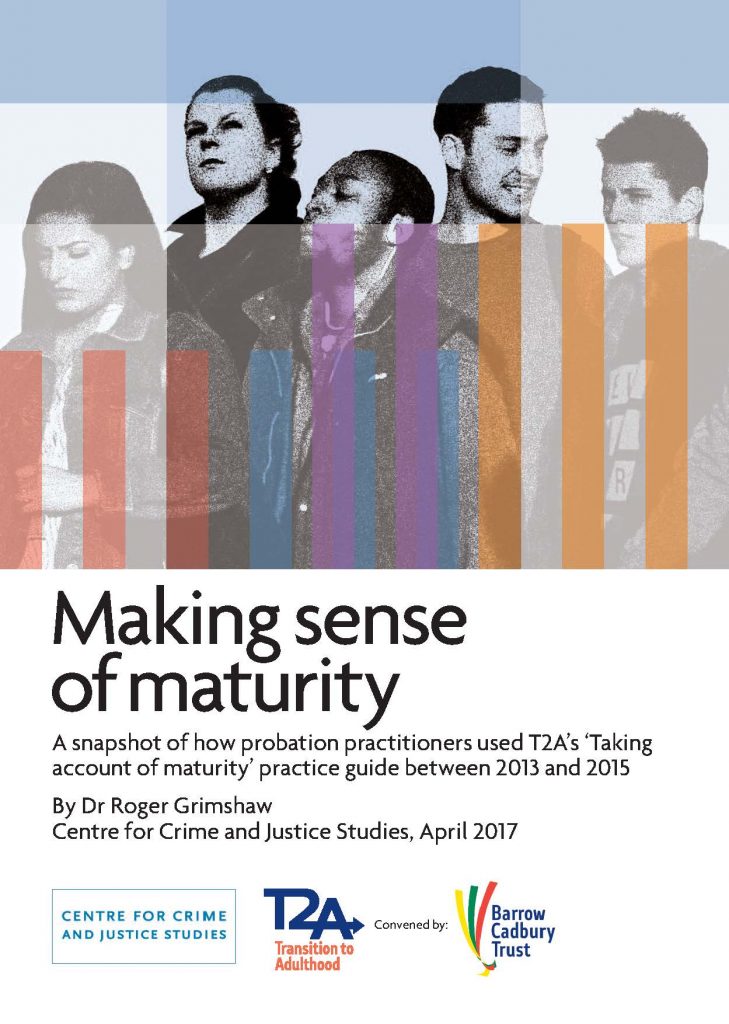
Roger Grimshaw, Research Director at the Centre for Crime and Justice Studies (CCJS) carried out research for T2A into how practitioners have been using T2A’s ‘Taking Account of Maturity’ guide which was published in 2013. His findings have just been published in his report ‘Making Sense of Maturity’.
In the publication Making Sense of Maturity, research with practitioners and managers shows ways in which the Guide was disseminated and embraced within probation services, and how they see it in the present context. We wanted to find out how the Guide was being used to develop frontline probation practice, to discover any ‘ripple’ effects (for example, on other agencies), to provide a template for monitoring use of the Guide and to scope out directions for future guidance.
Because fieldwork started in 2014, at the point when Transforming Rehabilitation brought abrupt structural changes, the research was delayed as probation grappled with its new priorities. Later, it proved possible to listen to practitioners who were operating with the Guide in the new context that prevails today. Amid the turbulence, the buy-in of senior management to promoting a maturity agenda was a factor in making the Guide a part of practice with young adults, though not all probation areas will have followed the same path. The Guide’s use was enhanced by practice briefings and support which could then chime with organisational delivery, especially by specialist teams.
Maturity looks different from the point of view of probation practice, because there are specific social pathways that have created challenges to the maturity of young adults under supervision.
‘So maturity is fundamental, it’s absolutely fundamental. About 30% of our young people have been in care. 50% of them didn’t finish school. Out of the 50% that did, only 5% got a formal qualification. So the rites of passage that you would normally associate with teenage growth and maturity, they just haven’t hit those milestones.’ (Probation manager)
Missing out on education, going through the care system, having difficulty communicating with agencies: these are just some of the experiences that need to be properly understood. Good communication and the development of trust are vital if young adults are to be engaged. Hence caseloads have to be adjusted to allow time for this sensitive work and other agencies must be fully engaged.
Crucially, the future health of maturity initiatives in probation depends on: an active strategic commitment to developing practice sensitive to the maturity of young adults; and an awareness of the pathways and milestones that a well-informed social policy binding together all agencies should address. If practitioners want to turn those conditions into reality, our research will give them plenty of ammunition and evidence.
